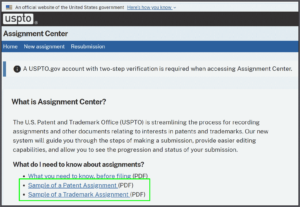
Ownership of property is a matter of state law, not federal law. Indeed for countries that are not the US, ownership of property is a matter of the law of the country involved. In the face of this, the USPTO has no business giving out legal advice about language to use in a patent assignment or trademark assignment.
Here is USPTO’s sample of a patent assignment (archived here).
Here is USPTO’s sample of a trademark assignment (archived here).
It is no easy trick listing all of the things that might be wrong with either of these recommended assignments, depending on the geographical location involved and the facts of the situation. But here are a few:
-
- There are places in Europe where an assignment is defective unless it is signed by the assignee.
- The patent assignment recites that the assignee is “desirous of acquiring”, a representation that only the assignee could make. But this representation is being placed in the mouth of the assignor.
- There may be jurisdictions where it is necessary to set forth not only the name of the assignee but also the place where it was incorporated or established.
- For a patent, there are many situations where the things that need to get assigned include not only the patent itself, but the right to sue for and collect damages for past infringements.
- For a patent application or trademark application, there are many situations where the things that need to get assigned include the right of priority appertaining to the application.
- The sample trademark assignment utterly fails to address an ITU (intent-to-use) filing basis, where the assignment will fail unless it is an assignment except to a successor to the applicant’s business, or portion of the business to which the mark pertains, if that business is ongoing and existing. See 15 USC § 1060.
- As for the patent assignment, depending upon the jurisdiction, it might be necessary to recite the consideration for the assignment.
- The sample patent assignment fails to address notarization, see 35 USC § 261.
- The sample trademark assignment fails to address notarization, see 15 USC § 1060.

I recorded an assignment for patent applications and it took two times for the patent application numbers to appear in the list of properties because it was giving me a “not found” message each time, and I am sure I didn’t type the numbers wrong.
Also, the entity type only appears for trademark assignments, not patents, as does the docket number. I suppose docket number option is only available for trademarks because we have to pay a fee for recording trademark assignments and not for patents.
It’s quite obvious that the USPTO rushed the implementation of its IPAS system without first working out all the kinks.
The USPTO demands compliance with their nonsensical rules and inconsistent procedures. Have you ever tried to file a trademark application onTEAS? It’s confusing and contradictory.